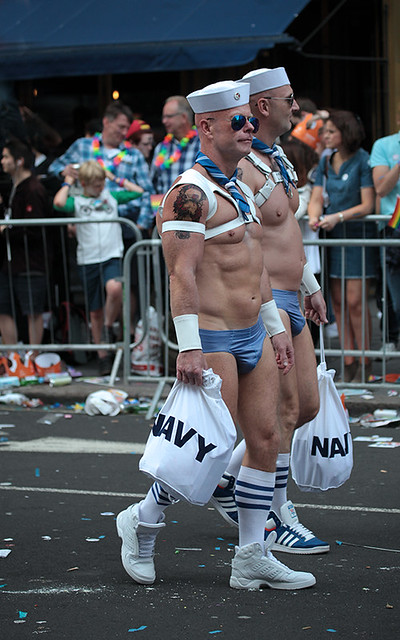Evan Wolfson on how to defend marriage equality during the rise of the antigay right

Evan Wolfson, one of the architects of marriage equality, is bringing the lessons and know-how that secured equality in 2015 to campaigns for equality across the globe. And with the new documentary The Freedom To Marry, filmmaker Eddie Rosenstein brings those lessons and Wolfson’s indefatigable optimism to the silver screen.
The Freedom to Marry, now in theaters nationwide, follows Wolfson and his colleagues in the months leading up to the Supreme Court’s Obergefeld v. Hodges decision. “I hope that the film makes people think about how to be effective advocates,” Wolfson says. With challenges to all things LGBTQ coming fast and furious, those lessons and that sense of hope are more important than ever.
Not long after the film’s premiere, Queerty chatted with Wolfson about how we should meet the myriad challenges ahead under Trump.
I’m guessing you expected The Freedom to Marry to premiere to a very different political moment. How has the 2016 election changed the way you think people will receive this film?
It’s really boosted the hunger for the inspiration and the elements of success that are shown in this film, which captures not just the story of how we achieved this transformation of hearts and minds and the law, but what are the building blocks and tactics and ways in which other causes and other movements can achieve their goals. We always wanted the film to deliver those lessons and point the way for others, but now it’s just really ratcheted up the desire to look at this model, look at the lessons and look at the power of hope that we brought to bear to achieve an extraordinary transformation from a very dark place to a glorious achievement. Of course, many of us find ourselves and our country in a dark place again. We need that inspiration and we need that instruction, and this film offers it.
When you see protesters taking to the street these days, what lessons do you think they can take away from the film?
I think there are many. One is that protesting is a way of raising your voice and encouraging others to believe and take action. But of course it’s only one piece of the work that’s needed. It’s not enough just to protest. We need to combine that energy with all of the other methodologies of social change, as Dr. King called them. We need to channel that energy into litigation, into legislative work, meeting with our lawmakers, putting pressure on them. We need to tell our stories not just with anger and determination, but with the tone and the reach and the kinds of examples and messages that will persuade others to change their minds. All of this is shown, not just told, in the film. Because all of those ways of building toward change were what we needed to do over more than four decades to go from being a despised, oppressed minority to claiming the full dignity and equality of the central language of love and commitment.
So the hope and the inspiration that we brought to our work and had to sustain through many, many stumbles and defeats, and the ways in which this movement followed a strategy and the way in which a campaign like Freedom to Marry worked with many partner organizations and millions of people coming into the movement to find the right combination over time to get the job done—those are the kinds of lessons that are portrayed with, hopefully, powerful stories that the filmmaker [Eddie Rosenstein] was able to somehow condense into 86 minutes.
It’s an inspiring film, but it almost feels like it’s missing an epilogue to reflect what’s happening in 2017. Do you think audiences will find it hard to square the film’s happy ending with the challenges to marriage rights we’re facing under Trump?
I actually haven’t heard people say that. This particular campaign, this 40-year journey, this struggle did have a happy ending. And that happy ending remains. More than a million gay people have gotten married. We have transformed the place of gay and transgender people in our society. We have moved the center of public opinion over to our side. We now see businesses fighting alongside us in these battles that we’re fighting, for example, for transgender rights. We see conservatives moving in our direction. All of this is the happy ending of this chapter. But of course, we all understand, and it’s 100 percent correct that it’s still just one chapter in an ongoing story, and winning marriage isn’t over. We’ve won marriage in law, but the marriage conversation, the power and the empathy and the visibility that we had to harness, now we can couple to the work ahead of us in the other battle ahead.
So, I understand what you mean, but I actually think that what’s happening now is people are watching the film, coming in with huge feelings of anger and despair and frustration and uncertainty—all rightly so. What they don’t need to be told everything stinks. Rather, here’s the pathway for the work that we need to recommit ourselves to.
Something you say in the film about the momentum Freedom to Marry kept gaining in the fight for same-sex marriage really stuck with me: “It’s not a done deal until it’s done.” Is it done now?
Great question. What I mean is— Well, first of all, nothing is ever 100 percent done. We know from history that you can spin out worst case scenarios where things can erode and can go really wrong. So, we can never just sit back and say everything is taken care of and we can be complacent. That said, I do think we have won marriage as a matter of law. More than a million gay people have gotten married. Even before we won in law, we won in the court of public opinion. That 63 percent support that we had built and earned by the time we stood before the Supreme Court in order to build the climate for the victory, that didn’t go away on Election Day. In fact, polling over the last couple of weeks shows that we’re still in the supermajority 60 percent range of American public opinion. We won not just the final Supreme Court ruling, but of course the Windsor case two year before in the Supreme Court and more than 70 court rulings in the two years between those two rulings. That didn’t go away on Election Day. There is tremendous power in what we achieved, and we shouldn’t just act like all of that vanished. Let’s not make a bad situation worse than it is. All of that is still there.
What I meant by it’s not over, is not so much that I fear we’re gonna have marriage taken away, but rather, even though we won marriage in law, the power of the marriage conversation and its ability to move hearts and create empathy and have more visibility for who gay and transgender people are is a conversation that is still reaching many people in many parts of the country, and we need to engage that power, not just put it on a shelf and act like that’s all done and now we’re starting from square one. To the contrary, the marriage victory is the gift that keeps on giving, as long as we keep using it. We need to harness that to the other work on other fronts that are also very important. There are many threats and many concerns in this terrible moment for our country. There’s no question our country is on the wrong track. But of all those threats and all those concerns, I would say that worrying that marriage will be take away is not at the top of the list. It’s possible, but it’s not at the top of the list.
President Trump has said he’s fine with gay marriage, that he considers marriage equality settled law, but he’s unpredictable. What do you make of the Trump administration’s position of same-sex marriage?
Well, as you just said, the administration’s declared policy is a little bit all over the map. Trump himself has said that the marriage decision is settled law and that he’s ok with that. But there is no such thing as 100 percent settled law. Things can change. We always have to be vigilant and engage in the work. And it’s not up to the president whether the Constitution’s demand is fulfilled or not, because we didn’t win marriage equality through the gift of a president, and we don’t lose it if the president doesn’t like it. What matters is ultimately that we remain vigilant and work hard to continue growing the public support, get more and more gay people married, create more facts on the ground, build such an extraordinary public acceptance—as we pretty much have already achieved—that even an opponent would think twice about trying to undo it. And then undoing it is not that simple. The only way to undo it—well there are two ways: one is to amend the Constitution, to take away the constitutional guarantees that the Supreme Court affirmed not once, but twice. Or to so dramatically change the composition of the court with justices who, even if they are opposed in their hearts, also are willing to overlook precedent and facts on the ground and public opinion and the course of history. That’s a tall order. Is it impossible? No. But is it the number one threat today? No.
But there are other ways that the administration can chip away at marriage rights. What sort of threat do so-called religious freedom bills pose to marriage equality?
Look, efforts to carve out licenses to discriminate in defiance of civil rights laws are definitely a threat. It’s definitely something that many in the administration and lamentably many in congress and even some on the Supreme Court want to do. Gay and transgender people are not the only targets of that tactic. We’ve already seen it directed at women, eroding reproductive freedom and access to healthcare. And, in fact, history tells us that this tactic of using religion as a way of dressing up efforts to undermine civil rights advances is nothing new. This is a familiar part of the classic pattern of civil rights advancement. We struggle hard, we are eventually able to achieve a civil rights victory, and then those who failed to stop it try to undermine it. And usually they turn to the phony banner of so-called religious freedom to mask these licenses to discriminate.
So, yes, it is a threat. Yes, it’s something we have to work to defeat. It’s something that didn’t begin with Donald Trump. It’s not a new problem. It’s part of the pattern of the work we have to do. Happily, our movement has actually defeated more of these attacks over the years than have passed. But every one that passes is one that we have to combat. But this is in a different category from taking away marriage. I don’t mean to sound like there’s no threat. Our country is very much on the wrong track. We all need to recommit to, really, defending our republic, and standing in solidarity with so many overlapping communities that are under attack, including LGBT, but also immigrants and Muslims and Jews and women and people of color in general. So many of us are under attack. We have to work together, stand together and do the work that this film shows how to do. But let’s not make a bad situation worse by spinning ourselves into fear. And that, I think, is another lesson from the Freedom to Marry work: you can spend forever cataloguing your fears and the obstacles and the difficulties, wallowing in negativity. Or you can set your eyes upward on the vision of the country you want to share. You can map out a pathway for what it’s going to take, and you can do that work, summoning others to rise rather than giving them permission not to act because they’re so paralyzed with fear. And that’s what we did successfully. That’s what the film shows, and I think that’s why it’s being embraced by audiences who come into the theater feeling frightened and sad, and leave with an example of how we can move forward.
The Supreme Court ruled on Roe v. Wade decades ago and we are still fighting that fight. Should we be worried that the right to marriage equality will play out the same way, that we’ll still be fighting to maintain the freedom to marry for decades to come?
I actually think that the fight that we’re really going to have to keep on fighting for a period of time is not so much, again, about marriage. It’s about gay and transgender rights. Marriage was an enormously important battleground on which we have now made tremendous gains for gay and transgender people. But that doesn’t mean that the anti-gay and anti-trans forces that are out there have completely vanished—although they are diminished. Part of the reason why we’ve seen so much of the right wing’s energy poured into anti-trans measures is because they know we have gained so much ground, comparatively on gay rights and that the marriage win moved the country so far forward on gay rights—and also forward on trans rights, but not as fully. But we’re fighting in a much better place, with far more support on our side now than before we engaged in the marriage battle. I mentioned earlier how businesses are some of the leading, most crucial champions now in these fights over transgender rights as well as efforts to carve out licenses to discriminate under the specious banner of religious freedom. Businesses were mobilized and brought into our movement enormously through the power of this marriage fight. All of that is now available and mobilized for us as we fight forward on the next frontier.
The NY Times published a story last month suggesting that Trump’s Supreme Court nominee Neil Gorsuch might be sympathetic to LGBT rights. How do you anticipate Gorsuch might shift the court on LGBT rights, and potentially marriage equality?
I think any nominee to the Supreme Court bears a very heavy burden of proving that she or he is committed to individual rights and equal protection, standing up for the most vulnerable. And I see nothing in his record to reassure me that he can meet that burden. Obviously we still have to have hearings. I think the fact that he might be a nice guy, or that he has gay friends is all well and good. But that has nothing to do with whether he, as a judge, has a jurisprudence and a record that gives us the assurance that he is qualified to serve on the Supreme Court as a defender of the Constitution’s guarantees, particularly with regard to individual rights and equal protections.
I think it’s even more acute in this case, because of course this seat is a stolen seat that Republicans in the Senate failed to fill for nearly a year. And the president making the appointment has no mandate, lost the popular vote and if there ever were a time when the advice and consent requirement of the Senate were a demand that the president find a moderate nominee who can get the votes on both sides of the aisle, it is this moment. And again, I think Judge Gorsuch is highly unlikely to meet that test. Every analysis I’ve seen of his record points to him being extremely right wing, to the right even of Scalia, and not likely able to meet the test I laid out a few moments ago. So I think absent some total surprise, and the fact that he may have some gay friends notwithstanding, his nomination should be opposed.
You shut down Freedom to Marry in 2015 after the Obergefeld decision. How did the public react to that?
The overwhelming response at the time, and actually ever since, was appreciation of the message that sent about a model of activism. We committed ourselves to clarity of goal, clarity of strategy and clarity of work, and said from the get-go that this organization is not gonna just lurch from thing to thing, jumping on something when it’s hot, running away when it’s difficult, but it was going to drive a strategy to a goal and bring in others, work with partners, and get the job done. And when that job was done—even though the work of the larger movement is not done—the work of this particular campaign is done, and so we closed. I continue to say the work of the movement is not done. I’m not done. The resources and assets and expertise and even staff that Freedom to Marry assembled, we transferred strategically over to other organizations in the movement. We didn’t just spend it all on vacations and a party! We invested in other pillar organizations in the movement because they have to continue to fight.
But I’m a real believer that the more you have clarity about your goal, that should dictate your strategy. The clearer you are about strategy, that dictates your structure, rather than trying to reinvent to find something to do. Again, these are elements of how we succeeded with the Freedom to Marry model that can be applied to others, and I think that’s why most people have been quite appreciative of the way we handled that.
That said, again, there are still enormous challenges and opportunities for moving forward. That’s why I’m spending my time now responding to requests for advice and assistants from other movements and other causes and other countries. I’m doing a fair amount of work with others in other countries trying to take these lessons and apply them to the work of winning marriage equality in their countries as a way of really tugging the whole human rights standard forward around the world. I’m drawing on my former Freedom to Marry team and the assets we have. Would it be nice if there were a million Freedom to Marry-type organizations doing those same things on all those different goals? Yes, and that’s a lesson that I think our movement and its funders ought to take very seriously. One of the things we did before shutting down was help launch a new campaign called Freedom for All Americans to play a similar role in trying to lay out a strategy and fill in the gaps and work collaboratively to try to drive non-discrimination around the country. And that organization is thriving and effective. Actually many of my former Freedom to Marry team have gone to work there.
At the same time, National Organization for Marriage didn’t shut down. There’s the Trump Administration’s First Amendment Defense Act lurks in the wings. The Texas Supreme Court is hearing the Pidgeon v. Turner case. Shouldn’t Freedom to Marry should be there to meet those challenges? What do you say to the criticism that shutting down the organization was perhaps premature?
I would say that that’s not true. We have extraordinarily strong partners who we worked with to win marriage, who are rightly stepping up to the defensive work and laying out the affirmative work that we need to do, whether it’s the four legal groups that were Freedom to Marry’s closest partners—the ACLU, GLAD in Massachusetts, Lambda Legal, National Center for Lesbian Rights; we have organizations that we helped create, like Freedom for All Americans, to take the Freedom to Marry playbook and apply it to non-discrimination and transgender rights. We have other partners in this movement who rightly are stepping up to play a bigger role now that the focus has shifted from everything needed to win marriage to everything needed to advance gay and transgender rights in other arenas. And the assets we built and delivered are very much available to those organizations. I myself remain an interested person and a part of this movement, and people are coming to me without an organization to hear me weigh in—as you are doing. So, the team we built and the model we drove was tailored to the strategy. It was a wonderful team. We were in our groove and I’m very proud of what we had. The wonderful people I had working together, they clearly would have been assets going forward. They still are. They’re just at other organizations now.
In the film, there’s a really lovely scene of your family talking about thinking you could have been the first Jewish president. And you would also have been the first openly gay president. So, are there any out politicians right now that you think could make a successful bid for the presidency in 2020?
There are a lot of people in public life whom I really admire. I guess I’m less focused now on who should run for president and more focused on the work we all need to be doing in the next year to massively ramp up civic engagement, all the work of terrific organizations like you and I just talked about, as well as in other movements. These movements overlap, whether it’s the ACLU or the National Immigration Law Center where I’m serving now as a pro bono senior advisor. There are many organizations that I’ve been coaching and advising. These organizations in gun control and environment and women’s rights and reproductive rights and so on, this is where we ought to be putting our energy right now. This is the crucial point that comes closer to what you’re asking, which is that we need to connect that civic engagement to the hard work on the ground first in key state and building toward Washington, to reclaim political power. We need to be political, even as we’re doing that civic engagement work, both defensive and affirmative. There are so many ways to be involved with that. It’s not just about finding a miracle candidate. It’s about doing all that work in all those different arenas, investing time and money and persuasion, standing in solidarity and connecting the case we’re making on particular battle to the larger vision we’re putting forward to win back our country.
You mentioned earlier that we need to get more gay people married. So I have to ask, after devoting over three decades of your life to same-sex marriage, do people ask you all the time to play matchmaker?
[Laughs] I wouldn’t say all the time. But friends who I’m dining with will say that to me, and of course I feel like I have to repay the favor from all those years when I was whinily single and asking my friends to help fix me up. And I kinda like trying to bring people together. One of the great things about having a positive vision of where you want to go—and particularly when it’s something like marriage which is so much about love and joy and family—is I do get to hear wonderful stories all the time from people who are thanking me for being able to get married. They tell me about how long they were together. Or parents will tell me about their kids or grandkids and how much joy has come into their lives. Non-gay people as well as gay people are sharing that joy. And that is a great thing to have. It’s something I’m very grateful and touched by. Still, every day I get those stories.
And I do try to play matchmaker where I can, spreading that joy.
www.queerty.com/evan-wolfson-defend-marriage-equality-rise-antigay-right-20170312?utm_source=feedburner&utm_medium=feed&utm_campaign=Feed%3A+queerty2+%28Queerty%29





